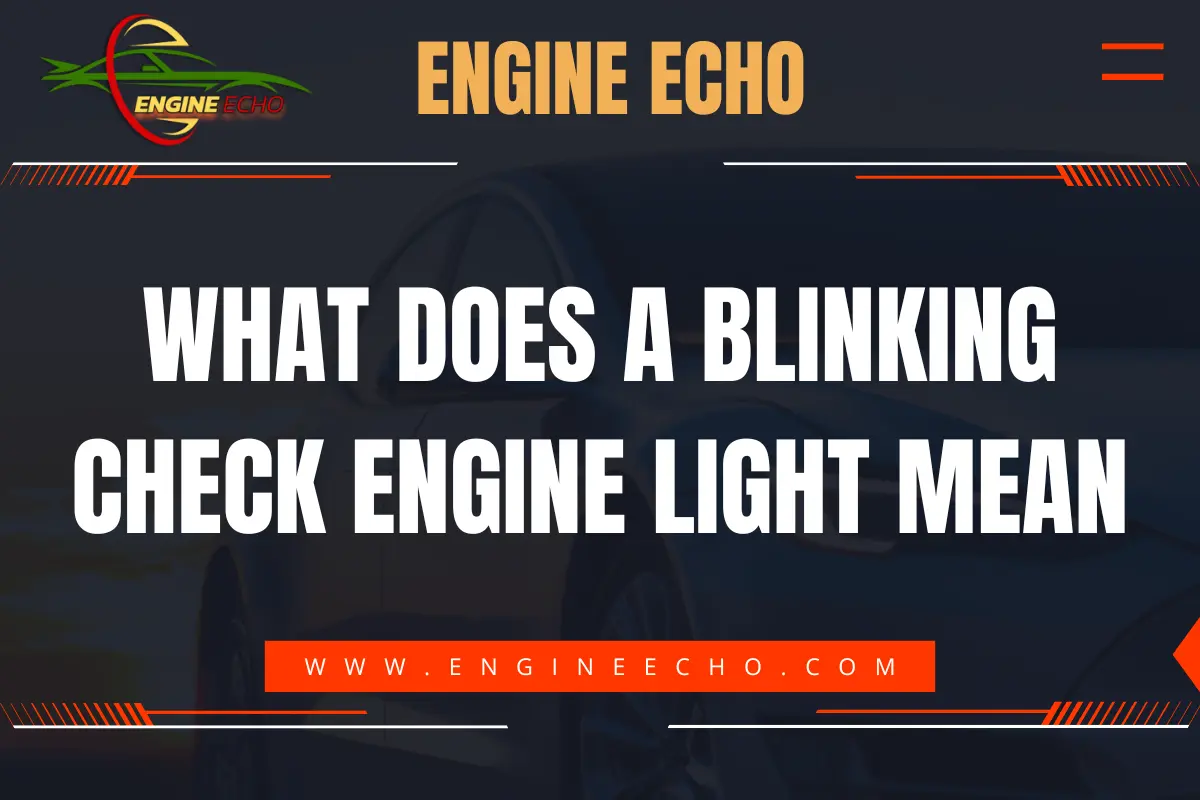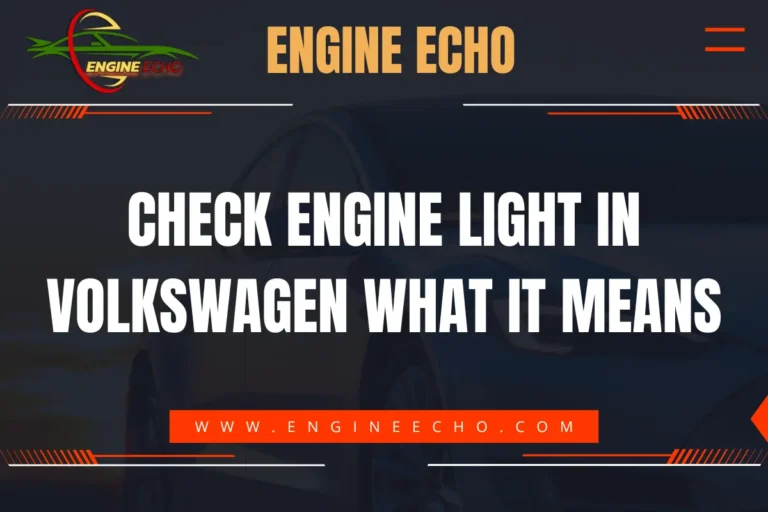What Does a Blinking Check Engine Light Mean?

Key Takeaway
- When that check engine light starts blinking, it’s your car’s way of saying, “Hey, we’ve got a serious problem here!” Trust me, you don’t want to ignore it. It could be something as bad as an engine misfire or a failing catalytic converter. Acting fast can save you from a world of trouble and some hefty repair bills.
Introduction
There are few things more unnerving for a driver than seeing a blinking check engine light. Think of it like your car waving a red flag, frantically trying to get your attention. I know when I see that, my heart skips a beat because it usually means trouble. This isn’t just a minor hiccup; it’s a sign that something is seriously wrong under the hood. Ignoring it is the last thing you want to do. Through this article, I want to help you understand what’s really going on when that light starts flashing and why you need to take it seriously.
What is a Check Engine Light?
That little light on your dashboard is your car’s way of saying, “Hey, something’s off here!” It’s an essential part of your vehicle’s system, keeping tabs on the engine and emissions. When it lights up, it’s trying to tell you something’s not right.
- Solid vs. Blinking Light: A solid check engine light usually signals a less urgent issue. Maybe you left the gas cap loose, or there’s a minor sensor glitch. But when that light starts blinking? It’s your cue to pull over as soon as possible—this is your vehicle’s way of shouting for immediate help.
- Common Triggers: There are many reasons this light might come on, ranging from something as simple as a loose gas cap to more concerning issues like engine misfires or a failing catalytic converter.
Why is My Check Engine Light Blinking?
So, why exactly is that light blinking? From what I’ve seen, a blinking check engine light usually means your engine is misfiring—basically, your engine’s having a rough day. When a cylinder in your engine fails to ignite properly, it can lead to incomplete combustion, which not only messes with performance but can also cause serious damage if not addressed.
- Blinking vs. Solid Light: While a solid light allows for some leeway, a blinking light is a definite no-go. You’re risking severe damage if you keep driving without getting it checked out.
- Attention Needed: I can’t stress this enough—when your check engine light is blinking, it’s time to pull over and figure out what’s going on. The quicker you act, the better your chances of preventing a minor issue from turning into a major repair job.
Common Causes of a Blinking Check Engine Light
Over the years, I’ve learned that there are a few usual culprits behind that blinking check engine light. Knowing these can save you a lot of stress and money down the road.
- Ignition System Issues
- Spark Plug Problems: Worn or faulty spark plugs are notorious for causing engine misfires, leading to that dreaded blinking light. I’ve had to replace mine more times than I can count, and it’s always a relief when a fresh set fixes the problem.
- Ignition Coil Failures: If the ignition coil isn’t delivering enough voltage to the spark plugs, misfires are almost guaranteed, and that light won’t stop blinking until it’s fixed.
- Fuel System Problems
- Faulty Fuel Injectors: Clogged or malfunctioning injectors disrupt the fuel-air mixture, which can trigger misfires and set off the check engine light. I had this issue once, and the rough ride that came with it was a clear sign something was up.
- Fuel Pump Issues: When the fuel pump fails, your engine might not get the fuel it needs, leading to misfires and that blinking warning light.
- Emission System Failures
- Oxygen Sensor Malfunctions: A faulty oxygen sensor can cause your engine to run too rich or too lean, triggering the check engine light. I’ve learned the hard way that leaving this unchecked can lead to more serious problems.
- Catalytic Converter Issues: If you’ve been ignoring misfires, your catalytic converter might be next on the chopping block, and trust me, you don’t want to deal with the cost of replacing this component.
- Engine Misfire
- What is an Engine Misfire? Simply put, an engine misfire happens when a cylinder fails to fire correctly, causing your engine to run rough. Not only is this bad for performance, but it’s also a common cause of a blinking check engine light.
- Relation to Blinking Light: Frequent misfires are the main reason your check engine light starts blinking, and addressing them quickly can save you from bigger headaches down the road.
- Severe Engine Damage
- Potential Scenarios: If you ignore that blinking light, the issues causing it can lead to severe engine damage. I’ve seen engines completely fail because the driver didn’t pull over in time.
- When to Stop Driving: The moment that light starts blinking, you should think about pulling over and getting your car checked out. It’s not worth risking further damage or a total engine failure.
Diagnosing a Blinking Check Engine Light
When that light starts flashing, it’s time to put on your detective hat. I’ve had my fair share of these moments, and I always start with a trusty OBD-II scanner.
- Using an OBD-II Scanner
- What is an OBD-II Scanner? This handy device reads the diagnostic trouble codes (DTCs) stored in your car’s computer. It’s like having your own personal mechanic in a box.
- How to Use It: Plug the scanner into the OBD-II port (usually under the dashboard), and you’ll get a readout of what’s causing the issue. I’ve used one of these countless times, and it’s saved me from unnecessary trips to the mechanic.
- Reading the Error Codes
- Understanding Codes: Each error code corresponds to a specific problem in your vehicle. Once you know the code, it’s easier to figure out what’s wrong and how to fix it.
- Common Codes: Some codes, like P0300 (random/multiple cylinder misfire detected), are often linked to a blinking check engine light. Recognizing these codes can help you understand the urgency of the situation.
- When to Seek Professional Help
- Indicators for Professional Diagnosis: If you’re unsure or the issue seems complex, don’t hesitate to seek professional help. There’s no shame in admitting that some problems are best left to the experts.
- Choosing a Mechanic: Look for a certified mechanic who knows how to handle these issues. From my experience, a good mechanic can be the difference between a quick fix and a drawn-out repair nightmare.
Immediate Steps to Take When Your Check Engine Light is Blinking
When that light starts blinking, your first thought might be panic—but don’t. Here’s what you need to do instead.
- Pull Over Safely
- Importance: A blinking check engine light means business. Pull over as soon as it’s safe to do so, and don’t try to push your luck by continuing to drive. I’ve seen firsthand how quickly a small issue can escalate.
- Safety Considerations: Make sure you’re in a safe spot away from traffic. The last thing you want is to deal with a car issue on a busy road.
- Check for Obvious Issues
- Inspect for Smoke or Leaks: Pop the hood and take a look. If you see smoke, strange odors, or fluid leaks, you’ve got a bigger problem on your hands, and it’s time to call for help.
- Reduce Engine Load
- Minimize Strain: If you need to drive to a safer location, do so gently. Avoid hard acceleration and keep the engine strain to a minimum to prevent further damage.
- Drive to a Safe Location
- Finding a Repair Shop: If the situation isn’t critical, drive slowly to the nearest repair shop. But if things look serious, it’s better to have the car towed. I always recommend erring on the side of caution here.
- Avoid Further Damage: Continuing to drive with a blinking check engine light is a gamble, and it’s one you’re likely to lose. Get the issue addressed as soon as possible.
Risks of Ignoring a Blinking Check Engine Light
I can’t stress this enough: ignoring a blinking check engine light is asking for trouble. Here’s why.
- Potential for Severe Engine Damage
- Keep driving with that light blinking, and you could be looking at catastrophic engine failure. I’ve seen it happen, and it’s never pretty.
- Increased Repair Costs
- The longer you wait, the worse the problem gets—and the more expensive the repairs will be. Believe me, what might have been a small repair can quickly turn into a costly ordeal.
- Safety Risks
- A blinking check engine light isn’t just a nuisance; it’s a serious safety risk. You’re not just endangering your vehicle but also your life and the lives of others on the road.
How to Prevent Future Blinking Check Engine Lights
Preventing that blinking light from coming back is all about being proactive. Here’s what I recommend.
- Regular Maintenance
- Importance of Servicing: Regular vehicle maintenance is like giving your car a health check-up. It helps catch small issues before they turn into big problems.
- Key Checks: Make sure components like spark plugs, fuel injectors, and oxygen sensors are regularly inspected. I’ve found that staying on top of these checks can prevent a lot of headaches down the road.
- Monitoring Vehicle Performance
- Early Signs to Watch For: Pay attention to how your car feels and sounds. If something seems off, don’t wait for the check engine light to confirm your suspicions.
- Using Technology: Nowadays, there are apps and devices that can monitor your vehicle’s health in real-time. I’ve started using one, and it’s a great way to stay ahead of potential issues.
- Timely Repairs
- Address Minor Issues Early: Don’t let small problems linger. Fixing them early can prevent bigger, more expensive issues later on.
- Benefits of Early Intervention: Not only does this save you money, but it also gives you peace of mind knowing your vehicle is in top shape.
Case Studies
- Case Study 1: Ignition Coil Failure
- Symptoms: A friend of mine once ignored rough idling and a blinking check engine light. By the time he got it checked out, the ignition coil had failed completely, leading to a costly repair.
- Diagnosis and Repair: After replacing the ignition coil, the car ran smoothly again. This taught me—and hopefully him—the importance of addressing issues early.
- Case Study 2: Catalytic Converter Damage
- Long-term Impact: I once knew someone who kept driving with a blinking check engine light for weeks. The result? His catalytic converter was toast, and it cost him a small fortune to fix.
- Repair Details: If he had addressed the issue sooner, it could have saved him a lot of money and stress. This is why I always recommend taking that blinking light seriously.
Conclusion
That blinking check engine light isn’t just a little annoyance—it’s your car’s way of yelling, “Help, something’s really wrong here!” From my experience, responding quickly to this warning can save you from costly repairs and potential safety hazards. Don’t take the risk. If your check engine light starts blinking, act immediately. Trust me, your wallet and your peace of mind will thank you.
Frequently Asked Questions (FAQs)
- Can I drive with a blinking check engine light?
- No, it is strongly advised to stop driving and address the issue immediately, as it indicates a serious problem.
- How much does it cost to fix the issues causing a blinking check engine light?
- Costs can vary widely depending on the underlying issue, ranging from a few hundred to several thousand dollars.
- Is a blinking check engine light an emergency?
- Yes, it is an urgent warning that should be addressed as soon as possible to avoid severe damage.
- What are the most common problems that trigger a blinking check engine light?
- Common causes include engine misfires, faulty spark plugs, ignition coil failures, and catalytic converter issues.
- How long can I drive with a blinking check engine light?
- You should not drive with a blinking check engine light. It is best to pull over safely and seek professional help immediately.
Thanks for checking out this article on EngineEcho.com! Hope you found this article: "What Does a Blinking Check Engine Light Mean?" helpful! If you liked it and want to dive into more car engine topics, head over to our homepage. There's always something new to discover in the world of engines. Enjoy your reading journey!
Check out our previous article: Best Cars with 3800 V6 Engines






